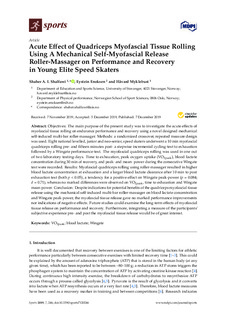Acute Effect of Quadriceps Myofascial Tissue Rolling Using A Mechanical Self-Myofascial Release Roller-Massager on Performance and Recovery in Young Elite Speed Skaters
Journal article, Peer reviewed
Published version
Permanent lenke
http://hdl.handle.net/11250/2632593Utgivelsesdato
2019-12Metadata
Vis full innførselSamlinger
Originalversjon
Shalfawi, S.A.I, Enoksen, E., Myklebus, H. (2019) Acute Effect of Quadriceps Myofascial Tissue Rolling Using A Mechanical Self-Myofascial Release Roller-Massager on Performance and Recovery in Young Elite Speed Skaters. Sports, 7(12), 246-?. https://doi.org/10.3390/sports7120246Sammendrag
Objectives: The main purpose of the present study was to investigate the acute effects of myofascial tissue rolling on endurance performance and recovery using a novel designed mechanical self-induced multi-bar roller-massager. Methods: a randomized crossover, repeated measure design was used. Eight national levelled, junior and neo-senior, speed skaters underwent a 10 min myofascial quadriceps rolling pre- and fifteen minutes post- a stepwise incremental cycling-test to exhaustion followed by a Wingate performance-test. The myofascial quadriceps rolling was used in one out of two laboratory testing-days. Time to exhaustion, peak oxygen uptake (VO2peak), blood lactate concentration during 30 min of recovery, and peak- and mean- power during the consecutive Wingate test were recorded. Results: Myofascial quadriceps rolling using roller-massager resulted in higher blood lactate concentration at exhaustion and a larger blood lactate clearance after 10 min to post exhaustion test (both p < 0.05), a tendency for a positive effect on Wingate peak-power (p = 0.084; d = 0.71), whereas no marked differences were observed on VO2peak, time to exhaustion and Wingate mean-power. Conclusion: Despite indications for potential benefits of the quadriceps myofascial tissue release using the mechanical self-induced multi-bar roller-massager on blood lactate concentration and Wingate peak-power, the myofascial tissue release gave no marked performance improvements nor indications of negative effects. Future studies could examine the long-term effects of myofascial tissue release on performance and recovery. Furthermore, integrating a measure of the participants’ subjective experience pre- and post the myofascial tissue release would be of great interest.

